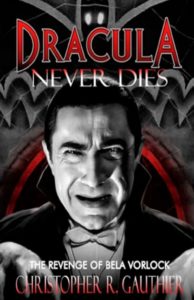
Review by Doug Gibson
Picture this passage from author Christopher R. Gauthier’s new novel, Dracula Never Dies: The Revenge of Bela Vorlock,” (Arcane Shadows Press, 2021):
Our protagonist, Vorlock, one-time horror film star, reduced to poverty row through two decades of abuse and betrayal by fellow actors, family members and media hacks — who rival Ayn Rand’s “Ellsworth M. Toohey” in evil — believes he is to receive a peer appreciation award for his decades as “Dracula” and other roles.
It turns out to be an elaborate, cruel joke. At that last minute the award is snatched away and instead given to a well-fed, successful acting rival, one who has abused Vorlock, and his immediate family, personally. With much laughing and sniggering, the Toohey-like MC thrusts a jester’s cap on Vorlock’s head.
It is an indignity gone too far. But I don’t want to give away too much of Gauthier’s excellent novel, part one of a planned trilogy).
—
I have a blurb on this edition’s back cover, and I have read earlier versions of Chris’ draft that total several hundred pages. Dracula Never Dies is nearly 300 pages. An appropriate one-sentence summary of the novel is an elegant primal scream of abuse, survival, more abuse, justice, and revenge.
There are no chapter breaks once Dracula Never Dies gets going. The narrator describes a life — with prose — that moves from passion to emotion to anguish to anger to regret to survival to despair to grief to irony to love to hate to gothic horror to revenge to resignation, and to perhaps 20 other emotions.
In an Amazon review, Robert Cremer, biographer of Bela Lugosi (Lugosi: The Man Behind the Cape), notes how Hollywood, its dreams and schemes that can destroy dreams, contributes to the gothic horror of the novel. (Cremer also has a blurb on the back cover.)
Cremer also notes a plus to the novel, that genre fans will recognize many references to characters, and events from the times of Bela Lugosi.
And, of course Dracula Never Dies’ protagonist Bela Vorlock is Bela Lugosi. This is an alternate biography of Bela Lugosi existing in another multiverse, with much of the plot including Lugosi’s times and life in our universe.
The plot — and I wish to reveal very little of particulars, more for the reader to enjoy — involves Vorlock’s youthful escape from patriarchal tyranny, an interlude of happiness and love, a period of success in the entertainment world, and his efforts to endure and survive while suffering personal and professional setbacks/betrayals.
Gauthier’s prose is magnificent. Expression is a key strength of his writing. Although their styles are different, Gauthier’s word craftmanship reminds me of the satisfaction of reading a good novel from E. Annie Proulx, author of “The Shipping News” and “Brokeback Mountain.”
Dracula Never Dies’ text demands to be read carefully. If it is glossed over the reader will get lost. Careful reading will provide a rewarding long, satisfying read.
After finishing the final two score of pages (in which a character who Ed Wood and Lugosi fans will recognize is included) I am already eager to read the next installment of Gauthier’s trilogy. Alas, it may be a while. I’ll be patient. Dracula Never dies is priced relatively inexpensively. I hope I can add a Kindle version to the dead tree edition I own.
This review is cross-posted at Plan9Crunch blog.
















